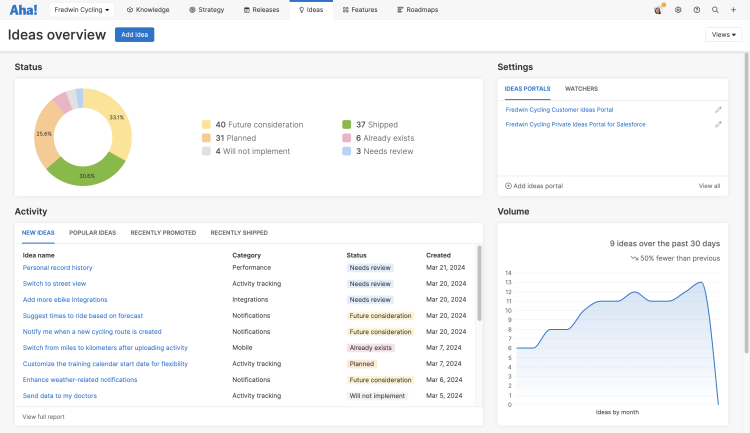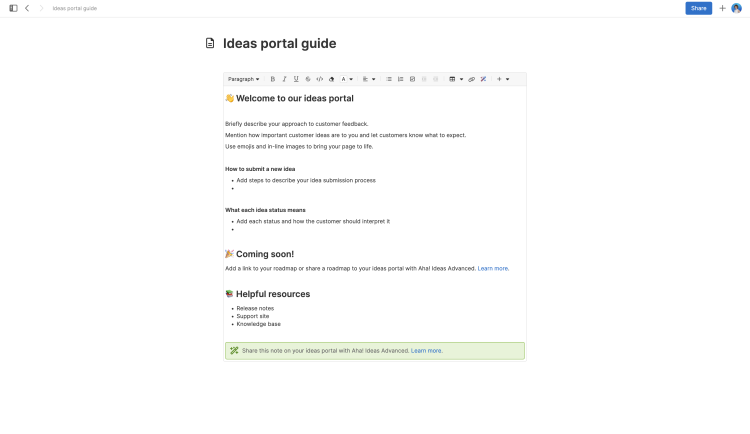What is idea management software?
Last updated: February 2024
Transforming product feedback into meaningful solutions requires concerted effort — idea management software can help streamline the process. It provides customers, teammates, and partners with an easy way to share their thoughts. Your product team uses the platform to sort and prioritize this feedback, measuring ideas against your product strategy and then identifying new features to include on your roadmap.
Build an idea management process using Aha! Ideas — free 30-day trial.

This is an example of a customer ideas portal available in Aha! Roadmaps and Aha! Ideas.
The result is a new or enhanced product continuously informed by meaningful customer needs. After all, when you understand what customers want, you can focus on defining and building new functionality that solves real-world problems. This ensures your product team builds a lovable product that satisfies customers and contributes to business growth.
Most product management teams today use purpose-built tools such as Aha! Ideas and Aha! Roadmaps to capture customer, colleague, or stakeholder feedback and requests in one place. This provides a unified approach for setting strategy, building roadmaps, and capturing ideas in one system and makes it easy to track ideas from concept to delivery. You can also automatically communicate the status of ideas to customers, keeping everyone informed of progress as it happens.
This guide will explore idea management software in depth. You should walk away with a solid understanding of what to look for and an overview of the essential software features — including advice from our own Aha! product team.
Use the following links to jump ahead to a specific section:
Why is idea management software important?
Ideas can come from anywhere: customer conversations, support tickets, employee roundtables, product demos, and more. Managing all these insights about your product is a big part of your role as a product manager. Done well, this helps you connect to what customers need, keep the flow of feedback organized, and focus on efforts that will make the most impact.
Some product managers use a mix of spreadsheets, emails, presentations, or note-taking apps to store and manage product feedback. But this gets overwhelming fast. When ideas are scattered, it is difficult to keep track of everything and prioritize which ideas will add the most value. Not to mention keeping customers up to date on progress — a time-consuming task if the entire process is manual.
Idea management software facilitates product feedback, organization, and evaluation in one central location. You can use it to establish a clear idea management process, helping you make sense of the feedback you receive and act on the best ideas quickly. By investing in robust idea management software, product managers can:
Streamline the collection of ideas from a wide range of sources
Facilitate internal collaboration among cross-functional teams
Prioritize ideas based on criteria such as feasibility, impact, and strategic alignment
Be transparent about which ideas are planned and which will not be implemented
Reduce the time spent on manual tracking and updates
Most importantly, idea management software helps product managers encourage a culture of communication. It provides the infrastructure for open dialogue, empowering customers and internal teams to share big ideas or acute pain points. This exchange helps product managers deeply understand their customers and helps customers build trust in the product.
Discover how to efficiently manage feedback and gain customer insights with idea management software like Aha! Ideas in the video below:
Editor's note: Although the video below still shows core functionality within Aha! software, some of the interface might be out of date. View our knowledge base for the most updated insights into Aha! software.

What should you look for in idea management software?
There are various idea management platforms out there, but none quite as robust as our own. (Yes, we are biased. But we have also honed what we offer by incorporating ideas from our own enterprise customers.) Of course, different tools offer different things — making it hard to know which is right for your organization. But we have expertise here and a strong point of view on what to look for.
We suggest a tool that allows you to:
Centralize feedback: Look for a tool that makes it easy to capture and manage ideas from a variety of sources and consolidate them in one location. Ideally, customers as well as colleagues can submit and vote on ideas. (It is even better if internal folks can submit proxy votes for customers, too.)
Organize ideas by theme: Grouping or tagging ideas helps you spot the most common themes. For example, you can group ideas as they relate to specific components of your product to identify the areas customers are most interested in.
Analyze trends: Reporting capabilities make it easy to track trending ideas by category and recent votes. This helps you quickly prioritize ideas with significant demand.
Score and prioritize: Scorecards provide a way to quantify the business value of ideas based on impact and effort. This helps you rank ideas and promote the most valuable ones to your roadmap.
Connect to your roadmap: Integrated idea management and roadmap software can help make the transition from idea to feature seamless. Promote the best ideas directly to your roadmap and follow features all the way through to delivery within the same system.
Communicate progress: Keeping customers, teams, and stakeholders updated on the status of ideas ensures transparency and makes people feel heard. Your tool should provide the ability to comment on ideas and send automatic notifications when the status of an idea changes.
Integrate with third-party systems: Integrating with other tools — such as customer relationship management (CRM) systems — can help bring your sales and support teams into your idea management and product planning processes by linking ideas with business and sales opportunities.

The Aha! Ideas overview page provides real-time insights into your submitted feedback — so you can prioritize work that aligns with customer needs.
Aha! Ideas is a good fit for folks looking to gain customer insights that drive their product development forward. You can seamlessly collect and prioritize ideas via a custom-branded portal. And there is breakthrough functionality, too — such as AI-powered ideas exploration for your internal teams and private ideas portals for your customers.
No matter which software you select, be sure to communicate the submission flow to your stakeholders and customers. Developing an ideas portal guide can help customers understand how to submit their ideas and what to expect from you in return. If you use Aha! Ideas, you can publish the guide as a custom page in your portal to make the process accessible and transparent to everyone.

Related:
Advanced features of idea management software
The best idea management software can be customized to fit how you work. For example, you might want to open ideation up to a general audience. This is great for crowdsourcing innovation. Or you might want to limit it to a few users with a specific submission form.
Your idea management software should give you the ability to control access and visibility with public and private options:
Public: Ideation is accessible to everyone. Customers can submit new ideas and vote on existing ones, giving them an unfiltered way to share feedback about your product.
Private: Only a select group can provide feedback and new ideas. These groups can include internal teams, partners, or a key set of customers.
You might need both public and private accessibility to organize and gather feedback about your product. The software you select should enable you to do this quickly — so you can manage every idea that comes in and establish a consistent workflow.
Other standout features to look for in idea management software include:
An ideas portal is a streamlined way to crowdsource feedback.
In Aha! Ideas, you can create as many portals as you need, customize them to match your brand, and even translate them into your users' preferred languages. | |
An overview page helps you manage all new and existing ideas in one place.
| |
Use research tools to better understand your customers and discover exactly what they need from your product.
| |
Analyze feedback efficiency and uncover customer trends using AI.
| |
Divide feedback based on individuals, companies, and segments to report on who needs what.
| |
Quantify the value of each idea by scoring against factors such as popularity, effort, and impact.
|
Related:
Idea management advice from the Aha! team
Our product team at Aha! uses our own idea management software to collect, review, and prioritize customer feedback that is submitted via a public ideas portal. These insights help inform how we build our products.
Our approach hinges on these principles:
Go goal-first: We set clear, measurable, and time-bound objectives. Any ideas that we promote to our roadmap link back to these top-level goals.
Be super responsive: We welcome customer feedback and review it quickly.
Prioritize ruthlessly: We use the Aha! product value scorecard to prioritize features and enhancements based on impact and effort.
Learn and adjust: We regularly revisit and adjust the details of our release plans to stay on course.
Idea management is about more than just collecting ideas. Recognizing that customers have a stake in your product and can positively influence its direction is really a mindset shift, too. When you embrace that mindset, you have a better chance of delivering what customers actually need.
Frequently asked questions about idea management software
Can idea management software be customized to fit a company's unique needs?
Absolutely. Your ideas portal should be a reflection of your company — it should match the look and feel of your brand and be set up to best fit your needs. The software you choose should allow for both public and private ideas portals or a submit-only option (where users can submit new ideas, but not view any other ideas in the portal). You should also be able to upload your logo and brand colors to your ideas portal and decide exactly how you want to communicate with users. Using customized email templates, for example, allows you to follow up with portal users in a way that matches your voice.
What privacy settings are available to protect sensitive ideas?
Most idea management tools should provide users with secure settings to protect sensitive intellectual property (such as ideas). For example, Aha! Ideas has a private ideas portal option that limits accessibility to a set of users you determine. These private portals provide a way for select groups — such as employees, partners, or key customers — to give feedback in a protected space.
Can idea management software be used alongside other tools and systems?
Yes. For example, customer-facing teams need a convenient way to capture requests and link ideas with business and sales opportunities. That is why CRM systems such as Salesforce and Zendesk should be easily integrated into your idea management software. That way, you can track all requests and customer communications in one view — so every team can stay focused on providing an excellent customer experience.


